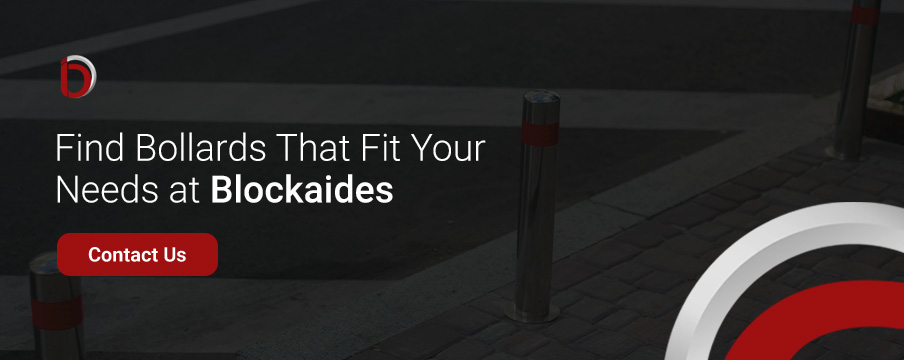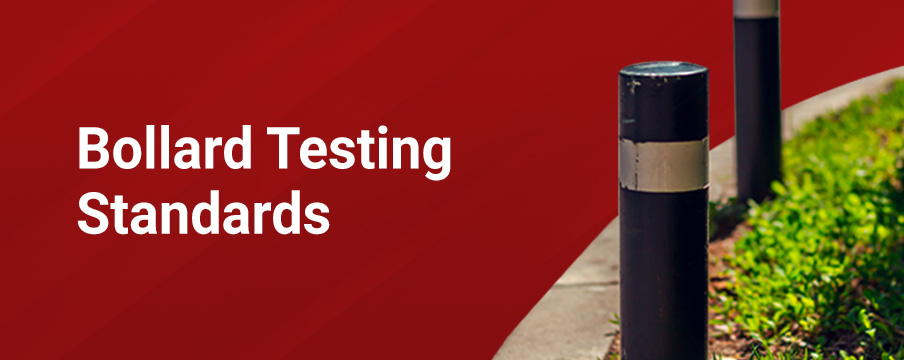
Take a look outside the front of any commercial building in an urban environment. Chances are, you’ve been walking past bollards every day. These posts are strategically placed at building entrances to shield against vehicle damage. Some are for drive-thru areas to prevent cars from touching the building, while others safeguard high-security facilities, stopping 60,000-pound trucks traveling at 50 mph. The requirements for a bollard are specific to the needs of the site, and crash ratings and testing standards have evolved to address those needs.
Bollards — built to strict bollard testing standards — play a crucial role in preventing vehicles from reaching buildings and causing harm to people. These sturdy structures also protect storefronts, saving time and money on property repairs. Some bollards are even designed to minimize harm to drivers and others can withstand terrorist attacks and deliberate destruction.
Crash testing standards are a means for contractors and architects to assess the effectiveness of these security devices. Today, it’s a regulated aspect of procuring vehicle security devices, ensuring you can make an informed purchasing decision.
The History of Crash-Rated Bollards
People have been driving into buildings and installing security devices for centuries. Since carriages were built and subsequently driven into storefronts, people began making bollards out of timber and, later on, cast iron.
When the British defeated the French in 1805 at the Battle of Trafalgar, they even used the French cannons — which were too large to be placed on British ships — as bollards in the East End of London. You can still find some there today.
While these historical bollards may have been suitable for the time, the U.S. Department of State (DoS) stepped in to develop some more contemporary bollard design standards in 1985. The standards they created were called K ratings, which assessed the bollards’ ability to prevent a vehicle’s bumper from passing the barrier.
These K-rated bollards worked well enough for most instances, but after the events of 9/11, a bollard’s ability to resist high-impact terrorist actions came into question. The results of a large vehicle at high speeds, possibly with explosives on board, are much more damaging than a driver who mistakenly presses the wrong pedal when pulling into a parking spot.
The DoS boosted bollard strength against terrorist attacks through research and raised testing standards. This led to M ratings, evaluating barriers’ performance in stopping a 15,000-pound truck between 30 and 50 mph. Another concern was explosives within the vehicle, so they also looked into structures that could prevent the flatbed of a truck from penetrating 3.3 feet or more past the security barrier and, by extension, into the building itself.
As people became interested in the K rating system, the American Society for Testing and Materials (ASTM) introduced their own bollard rating system. This one measured how far the vehicle would penetrate security barriers at different speeds and vehicle weights.
The DoS then adopted the ASTM approach. As a result, ASTM ratings have mostly overtaken the K ratings, but you may hear K ratings used as shorthand in the industry when people talk about crash-rated bollards. Instead of K ratings, ASTM now divides classifications based on the vehicles they address — into C, P, M and H standards — which we’ll cover in more detail later. ASTM bollards cover various impact types and include low-speed bollard crash performance testing.
In the U.K., you’ll find similar Publicly Available Specifications (PAS) ratings, developed with input from the Centre for the Protection of National Infrastructure (CPNI) and the British Standards Institution (BSI). Input from all of these organizations, as well as the DoS, helped to create the International Workshop Agreement (IWA) standard 14.
Low-Speed vs. High-Speed Crash Testing Standards

The various types of crash testing and testing standards focus on several different classification areas that offer information based on factors like speed, weight and support structures. The potential for vehicles to penetrate a security barrier rises with speed and weight. Some barriers need to be ready for vehicles moving at highway speeds, while others are more likely to see impacts at low speeds.
Low-speed incidents may be more likely for storefronts and drive-thrus in urban areas — with collisions related to pedal errors in parking lots. High-speed incidents can occur more often in businesses that are next to interstates or that may be targets of terrorist activity. Financial institutions, banks, military bases, arenas or other places that hold high volumes of guests can be examples of these places. Each type of crash can be reduced in severity with different types of bollards that address their distinct impact characteristics.
ASTM standards include F2656 — which tests for high-speed impact — and F3016 — which addresses low-speed impacts below 30 mph. Speed affects penetration ratings, so determine the type of impact protection you need.
High-speed and low-speed testing often become a matter of security vs. safety. Low-speed testing usually involves protecting a storefront and pedestrians from vehicle movement that occurs from incidents like pedal error. In urban areas that have tight quarters and close-fitting structures, a difference of a few feet can prevent heavy damage to property, utility boxes and passersby.
High-security buildings, such as banks and government facilities, must halt fast, large and malicious vehicles. These institutions can place bollards farther from the entrance to allow for greater penetration distances. The difference in speeds helps to more accurately select bollards that will respond best to the traffic conditions and likely threats.
What Are the Crash Test Ratings for Bollards?
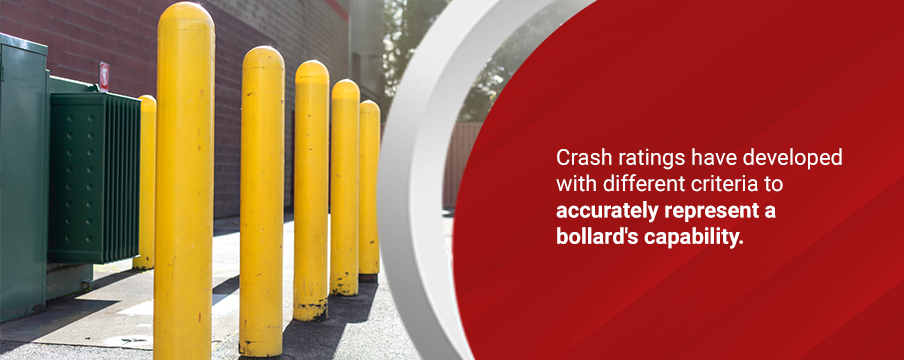
Crash ratings have developed with different criteria to accurately represent a bollard’s capability. As more threats have become present, more detailed specifications were created to address them. These include the ASTM bollard standards, K ratings and WK ratings, each from different institutions attempting to cover different areas of bollard safety.
ASTM Bollard Standards
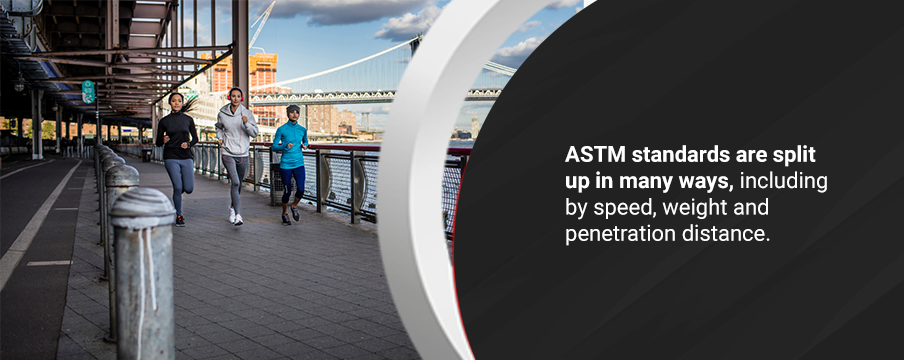
Let’s talk about three major ASTM standards that you’ll need to be aware of — F3016, F3016M and F2656-07:
F3016 was developed to create a repeatable test to apply rating designations based on vehicle impact to security devices like bollards and fences. Surrogate test vehicles are used, which include impactor zones at the nose alongside a target penetration rating. As we’ve discussed, this standard includes ratings for different vehicle sizes and speeds. F3016M is commonly used in reference to medium-duty vehicles that weigh 15,000 pounds.
F2656-07 has a similarly defined set of classifications but is intended for anti-ram purposes. It typically covers high-security requirements, such as those for military areas, financial institutions or government buildings. This makes higher speeds and weights necessary components of the testing. These crash testing standards are rated with speeds of 30 to 50 mph.
K-Rated and M-Rated Bollards

As we mentioned earlier, K ratings were developed by the DoS in the ’80s based on the penetration distance of a vehicle’s front bumper past a security barrier. This kind of barrier includes fences and gates as well as bollards. Since the inception of K ratings, M ratings have emerged, which are more focused on the distance of the payload and developed from ASTM testing standards. Both involve the medium-duty 15,000-pound vehicle.
K ratings are still used frequently in industry talks, but officially, the M ratings are more appropriate.
WK Ratings
WK ratings are another type of rating from the ASTM, but these are under development and intended to address errant vehicles. They can include items like barriers, gates, planters and more — in addition to bollards. This bollard testing standard covers low-speed vehicles and situations that may not be addressed with high-security bollards, which could allow smaller vehicles through if not spaced properly.
Different ASTM Models and Codes Used
ASTM standards are split up in many ways, including by speed, weight and penetration distance. F3016 addresses vehicles at lower speeds and allows minimal penetration lengths, with a maximum of 4 feet. Several factors help determine the speed and penetration ratings.
Speed ratings for this classification are based on vehicles of 5,000 pounds, with 110 pounds plus or minus, and separated into three categories:
- S10: Nominal minimum test velocity of 10 mph and a permissible speed range of 9.0 to 18.9 mph.
- S20: Nominal minimum test velocity of 20 mph and a permissible speed range of 19.0 to 27.4 mph.
- S30: Nominal minimum test velocity of 30 mph and a permissible speed range of 27.5 to 32.5 mph.
Penetration ratings are also a part of both low and high-speed ASTM standards and reflect how far a vehicle can penetrate the security barrier. For low-speed vehicles, the ratings are:
- P1: Less than 1 foot.
- P2: Between 1 and 4 feet.
- Failure: Greater than 4 feet.
High-speed crash codes are divided into sections based on the size of the car used for testing. Among these categories, each is divided based on speed, tacking on the speed in mph after the letter. Speeds include 30, 40 and 50 mph. For instance, an M30-rated bollard is tested against a medium-duty truck going 30 mph. The size categories include:
- C ratings: For small passenger cars of 2,430 pounds.
- PU ratings: For pickup trucks of 5,070 pounds.
- M ratings: For medium-duty trucks of 15,000 pounds.
- H ratings: For heavy goods vehicles of 65,000 pounds.
Penetration ratings for high-speed standards are as follows and apply to all vehicle sizes:
- P1: Less than 3.3 feet.
- P2: Between 3.31 and 23.0 feet.
- P3: Between 23.1 and 98.4 feet.
These bollard testing standards have helped to develop safer options for buildings around the globe. Before the adoption of F3016 and F2656-07, the strength of bollards was more unknown and — unless you had an engineer on hand — it was challenging for contractors or project organizers to select the appropriate ones.
Creating F3016 and the distinctions within have made it easier to choose bollards that match a site’s traffic needs and threat levels. The bollards can be chosen that will be more likely to withstand the types of incidences that may occur at a location.
Of course, it also created a practical manner of testing that was consistent and based on the actual stopping power of the bollard. An industry standard is a vital part of creating safer materials that everyone can rely on. For high-security needs, the ASTM standards addressed many characteristics that were not covered by the K ratings that were available.
How K Ratings Compare to M Ratings
K ratings were developed by the DoS and later replaced by M ratings, but the industry still commonly refers to K ratings when measuring the strength of a bollard.
K ratings are divided into the following distances:
- L3: Less than 3 feet.
- L2: Between 3 and 20 feet.
- L1: Between 20 and 50 feet.
The more modern M ratings are listed in the above section as part of the ASTM standards. Penetration distances are included in each code.
Remember how we mentioned that M ratings are divided based on speed? M30, M40 and M50 ratings are for vehicles going 30, 40 and 50 mph, respectively. K ratings work similarly, with K4, K8 and K12 respectively representing 30, 40 and 50 mph tests. For example, K12-rated bollards are tested at 50 mph.
K-rated bollards were a necessary advancement in safety when they first came around in the last century, but when the threat of terrorism became more pronounced, security experts realized they needed something more robust to prevent ramming attacks. By switching to M ratings and ASTM testing standards, trust in bollards to resist high-speed, heavyweight impacts grew. They became a more reliable method of resisting terrorism and theft through vehicle ramming attempts.
The Importance of Crash Testing Standards
Uncertified bollards have unknown resistance levels. Certification ensures informed, safe decisions and is crucial in case of incidents and potential legal action. Understanding the rigorous standards underscores the importance of bollards for facility safety and security.
Crash testing standards also allow you to more accurately select bollards that fit the specific needs of your building. Just because something is “certified” doesn’t mean it is appropriate for your needs. Ensure that when you purchase bollards, you buy ones rated for the correct environment. A high-security location needs more protection than some F3016 bollards can handle.
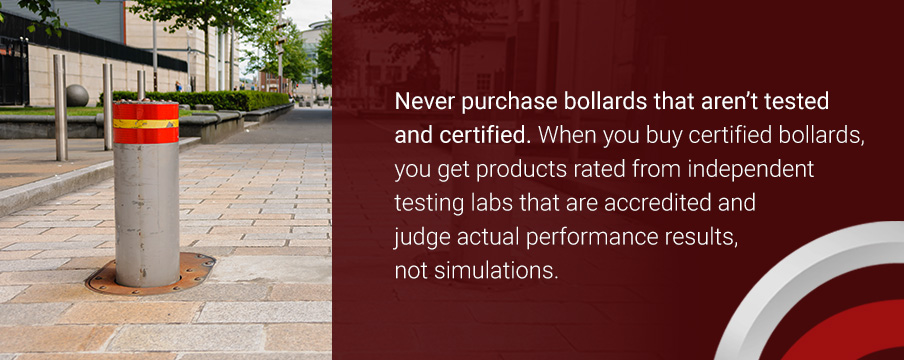
Never purchase bollards that aren’t tested and certified. When you buy certified bollards, you get products rated from independent testing labs that are accredited and judge actual performance results, not simulations. Also, ensure that you know what kind of bollard you are buying. The codes reflect many aspects of their characteristics and are crucial in selecting the right ones. Be certain you have a thorough understanding of what each part of the crash codes means so you can purchase the best bollards for your application.
What Crash-Rated Bollard Do You Need?
You don’t need to be an expert in engineering or security to purchase bollards for a site, but you do need to have a little bit of basic knowledge of them. Purchasing bollards requires you to know a few details about the nature of your site, like:
- Traffic patterns: How do vehicles move around the area?
- Likely threats: What potential dangers should you prepare for?
- Vehicle impact: How might vehicles affect your building?
- Damage priorities: Is protecting people or the building more critical?
- Speed requirements: Do you need to stop fast or slow-moving vehicles?
- Spacing: How much distance is there between your barrier and the building?
- Aesthetics: Should bollards enhance the building’s appearance or guide traffic?
- Pedestrian flow: How important is smooth walking for the area where bollards will be placed?
Knowing the answers to questions like these will help you better fit the bollard to the safety needs of your application.
Another component you’ll need to consider is state and federal requirements for crash-rated materials. Many locations need to meet certain requirements to be compliant, and you’ll need to know these and the bollard code requirements for your purposes.
For security purposes, bollards are a type of anti-vehicle barrier (AVB) or vehicle security barrier (VSB) employed in plenty of high-security facilities. You may also see them referred to as passive barrier systems, meaning they don’t move and are fixtures that rely on absorbing energy, transferring it into the foundation.
Often, you may need to use bollards in conjunction with other devices or structures that can reduce the speed of an oncoming vehicle.
Aside from federal and state regulations, you may find suggestions from these entities as well, which would be good to follow. Any structures built after 2009 use the ASTM standards. Before that, you may find bollards rated with the K system in place.
Once you know your site characteristics and federal and state requirements, you can begin to select a bollard. Check that you are looking under the appropriate ASTM bollard standard, F2656 or F3016, and identify appropriate speeds and vehicle weights.
If small cars are your main concern and space is limited, focus on C and P ratings. Avoid using light-impact bollards when heavy-duty models are required for top safety. This selection can provide less effective results in an environment where safety should be the utmost priority.
Bollard design standards were designed to protect people, and skimping here can lead to injuries or worse and could put your facility at risk for litigation. Make sure you purchase bollards that are correctly rated for the environment you’ll be putting them in. Different designs, such as retractable bollards or planters, can also work better in some applications, depending on the layout of your site and your goals.
Find Bollards That Fit Your Needs at Blockaides
Now that you’re familiar with bollard crash testing standards, you can make informed decisions for your site. Assess your location’s traffic patterns, threats and proximity to the security barrier. Consider vehicle sizes, penetration distances and speeds when choosing bollards. Always opt for certified, crash-rated bollards to ensure they’re tested for real-world scenarios.
If you’re clear on your bollard needs or want more information on safety ratings and tests, Blockaides is here to assist. We offer various products designed to enhance safety and security for everyday destinations.
We’ll collaborate with you to identify your project’s requirements and recommend the most suitable crash-rated bollards to protect your visitors, staff and building. Our dedication to safety guides our manufacturing and customer service.
For further details on safety ratings or project-specific advice, get in touch with our team today. Alternatively, if you know what you need, browse our selection of bollards.

